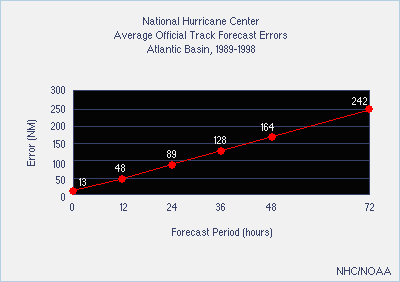|
Forecasters Hurricane Track Forecasts: Forecasters must analyze a huge amount of data, including conflicting computer model results, and come up with their best estimate of a three-day track and intensity forecast. Just as it is easier to predict where you will be 12 hours from now as opposed to 72 hours, it is easier to predict where a hurricane will be right before it makes landfall (although hurricanes can, and do, unexpectedly alter course). The figure below shows that, at shorter forecast time periods, the forecast track error is fairly small, but when the forecast is farther in the future, the error increases significantly. Knowing these estimated errors can help you assess your potential risk.

Forecasters convey track uncertainty through the strike probability tables and strike probability graphics which show the areas likely to be affected by the tropical cyclone. These products are based on the current best forecast track and the past distribution of errors. They are created to indicate the statistical chance that the hurricane center will pass within 65 NM (75 mi) of a location within 3 days of the initial forecast time. The maximum probabilities by forecast period are displayed in the table below and are based on NHC's average
forecast errors for the various periods. For example, if a hurricane is expected to make landfall in 48 hours at
New Orleans, the highest the probability can be is 25%. Most coastal locations need to start evacuations by 48
hours in order to have them completed before the tropical storm-force winds arrive. New Orleans, because of its
low terrain and high population, must start preparations much earlier-when probabilities are even lower.
*These probabilities are those which would be computed if the forecast position (at the given time period) were directly over a community. A range of probabilities is given because forecast errors differ by location. The probability can be 100% if the center is already close to a location. In addition, the probabilities can exceed the maximums listed in the table if the hurricane center is actually forecast to be at the location at an earlier time period. Why Emergency Managers Can't Wait Improvements and Limitations in Track Forecasting Hurricane Intensity Forecasts: Much like the difficulties in forecasting a hurricane's track, hurricane specialists are challenged to predict the exact strength (in terms of wind speed) of a tropical cyclone. The average errors for intensity are shown below.
Although the average intensity errors are fairly small, they can be much larger in certain cases. Hurricane specialists have an especially difficult time forecasting rapidly intensifying storms. The NHC provides graphs and tables to show intensity probabilities based on the current intensity forecast and the past error history. Forecasting changes in the size of a hurricane is extremely difficult due to the complex interactions between the environment and the storm. Additionally, observations that could help accurately define the initial size of the entire circulation are very sparse over the ocean where the storm spends most of its life. Limitations in Intensity Forecasting Because of these uncertainties, and because the forecast probabilities are so small, emergency managers frequently have to make critical decisions based on strike probabilities of less than 25%, using forecasts that may have significant errors. However, since the goal is to save lives, the best course of action is to act conservatively and take into account those uncertainties in order to determine what the worst-case situation might be and what measures would be appropriate. More times than not, the preparations will have been unnecessary (in hindsight) because the hurricane will probably miss you much more often than it will hit you. But that one time when the hurricane comes right to your front door, these precautions will have been worth it many times over. Test Your Understanding: |
